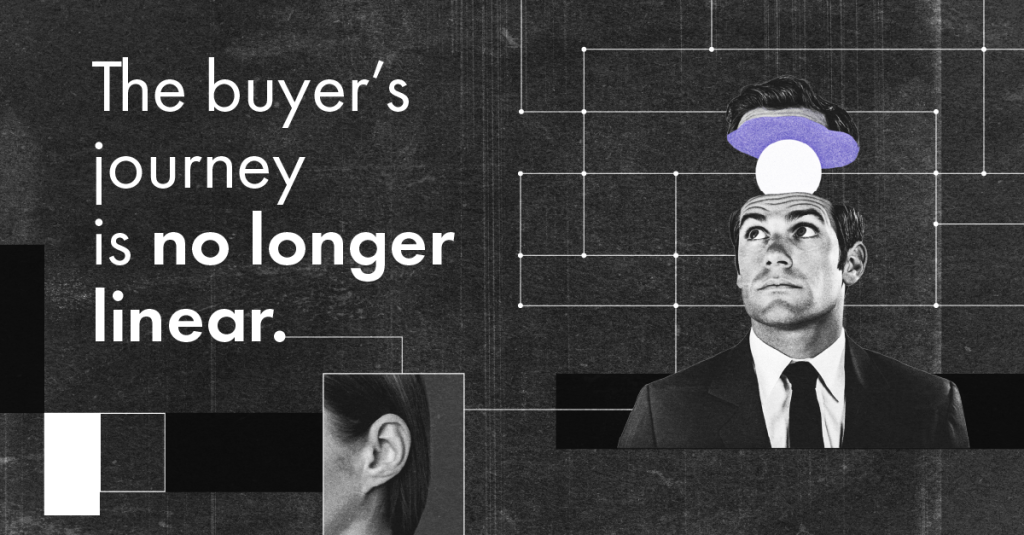
The buyers journey is no longer linear: here’s how marketers should adapt
Published on 2 April, 2025 | Author: Drew Flowerday
The days of the buyer’s journey being a simple, linear path are long gone. Picture this: a potential customer strolls into a store, browses the aisles, and leaves with a purchase. Now, fast-forward to today, where the buyer’s journey is far from predictable. In fact, it’s anything but linear.
So, what does that mean for you as a marketer? It means it’s time to evolve. The digital world is constantly changing, and with it, how buyers make decisions. They’re researching, engaging, and deciding at their own pace and on their own terms. The journey isn’t a straight line anymore – it’s more like a winding road with a lot of twists and turns.
The shift: from linear to non-linear
Traditionally, marketers would think of the buyer’s journey as a funnel: awareness at the top, consideration in the middle, and decision at the bottom. Buyers moved through these stages predictably, often in the same order.
But today? Not so much. The reality is that buyers can jump from one stage to another, loop back around, and sometimes even skip entire stages altogether. Imagine someone first discovering your product through a social media post, then researching it in detail on review sites, and finally reaching out to your sales team for clarification. Or, what if they decide to take a deep dive into comparison articles before ever thinking about buying?
This shift requires marketers to rethink how they engage with potential customers. If the journey is no longer linear, how do you effectively guide your prospects? Let’s explore some strategies that can help you keep up with this new buying behavior.
Meet your customers where they are
Buyers today don’t follow a predictable path. Some may start their journey on social media, while others may dive straight into Google searches. They could land on your website, check out a blog post, and then get distracted by an email campaign you sent. The key here is to meet them where they are.
Rather than trying to force buyers down a specific path, your job is to create an ecosystem where they can interact with your brand through multiple touchpoints. That means having a strong presence on social media, maintaining an informative website, offering value through blog content, using email marketing to stay top of mind, and more.
When a customer encounters your Instagram post, that’s often their first touchpoint. If they later decide to explore your blog post, that becomes another interaction. These touchpoints aren’t linear; they’re interconnected and fluid, offering customers the flexibility to engage with your brand on their own terms.
The beauty of this approach is that it doesn’t require a strict order — customers can navigate through your content in whatever sequence feels natural to them. By having a strategy that prioritizes seamless integration across platforms, you allow your audience to move effortlessly between touchpoints.
This flexibility not only enhances their experience but also encourages deeper engagement, as they’re able to explore your brand in a way that aligns with their preferences and needs.
Be consistent, but flexible
While the journey may not be linear, one thing is still true: buyers want consistency in their experience. Whether they’re reading a blog, watching a video, or interacting with your sales team, they want the messaging to align across all channels.
However, flexibility is also key. Different stages of the journey require different messaging. For instance, someone just becoming aware of your brand will need educational content that explains your value proposition. Meanwhile, a more informed buyer might want detailed case studies or product demos.
Marketers need to ensure they’re offering the right content at the right time, while still maintaining a consistent voice and messaging. This could mean creating a content map that tracks the various stages of the customer journey, allowing you to deliver personalized, timely content at each step.
Leverage technology to understand buyer behavior
To navigate this non-linear journey, it’s crucial to use data and technology to your advantage. Tools like Customer Relationship Management (CRM) software, AI-driven analytics, and marketing automation platforms can help track customer behavior in real-time. By understanding how buyers are interacting with your brand, you can tailor your marketing efforts to suit their needs.
For example, let’s say a potential buyer has visited your product page a few times but hasn’t taken any action. With the right technology, you can trigger an email reminding them of the benefits or offer a limited-time discount to encourage a purchase.
The beauty of these tools is that they give you insights into where customers are in their journey, even if they haven’t made a decision yet. You can then act on these insights to provide the right nudge at the right time.
Focus on education, not just promotion
In today’s non-linear journey, buyers are often in “research mode” for longer periods. They’re looking for information, advice, and validation before making a decision. This means your role as a marketer is shifting from purely promotional to partly educational.
What if instead of pushing for the sale at every turn, you gave buyers the knowledge they need to make an informed decision? Providing value-driven content such as how-to guides, product comparisons, and industry insights can help build trust with potential customers.
By positioning your brand as a helpful resource, you build relationships that are based on trust and value, not just transactions. This will not only help your customers make better decisions but also increase the likelihood that they will turn to you when they’re ready to purchase.
Embrace omnichannel marketing
Since the buyer’s journey is no longer confined to a single channel, marketers need to think omnichannel. This means integrating multiple platforms and touchpoints to ensure a seamless experience.
Omnichannel marketing is all about creating a unified experience that ensures your brand is present and consistent across every touchpoint. This kind of approach helps build stronger relationships and ensures that no matter where a customer is in their journey, they can interact with your brand effortlessly.
The future of marketing is dynamic
As marketers, we need to let go of the old notion that the buyer’s journey is a rigid, linear path. Instead, we must embrace the idea that the journey is dynamic, constantly evolving and changing By understanding that buyers move in their own unique way, we can build more flexible, personalized, and engaging experiences.
So, how can you adapt? Start by creating content that caters to every stage, meet your customers where they are, and use technology to gain deeper insights into their behavior. Perhaps most importantly, focus on building relationships based on trust and value, not just sales. The new buyer’s journey may be unpredictable, but with the right strategies, you’ll be ready to guide them to the finish line – wherever that may be.
